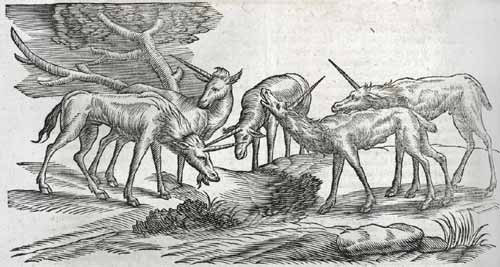
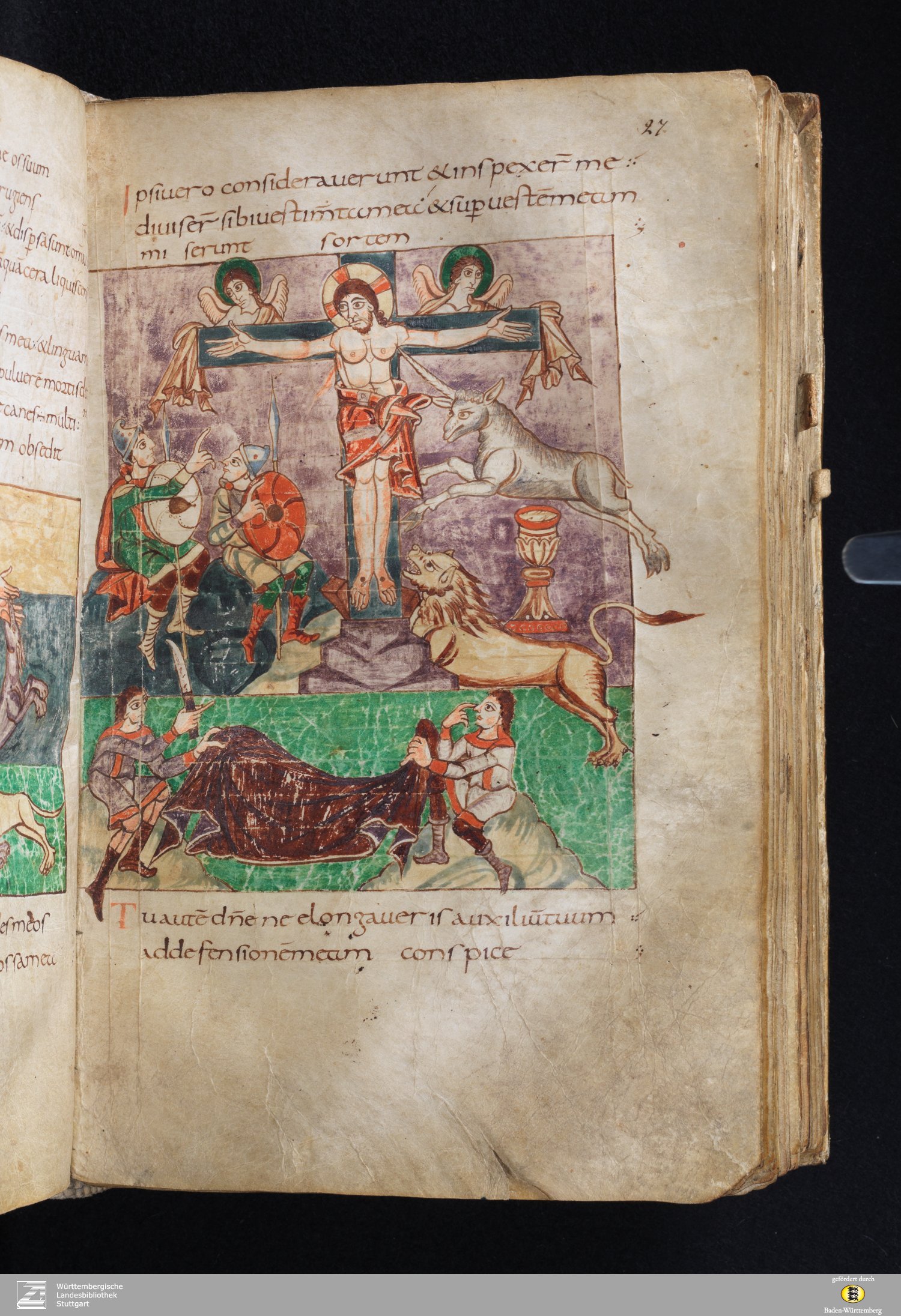
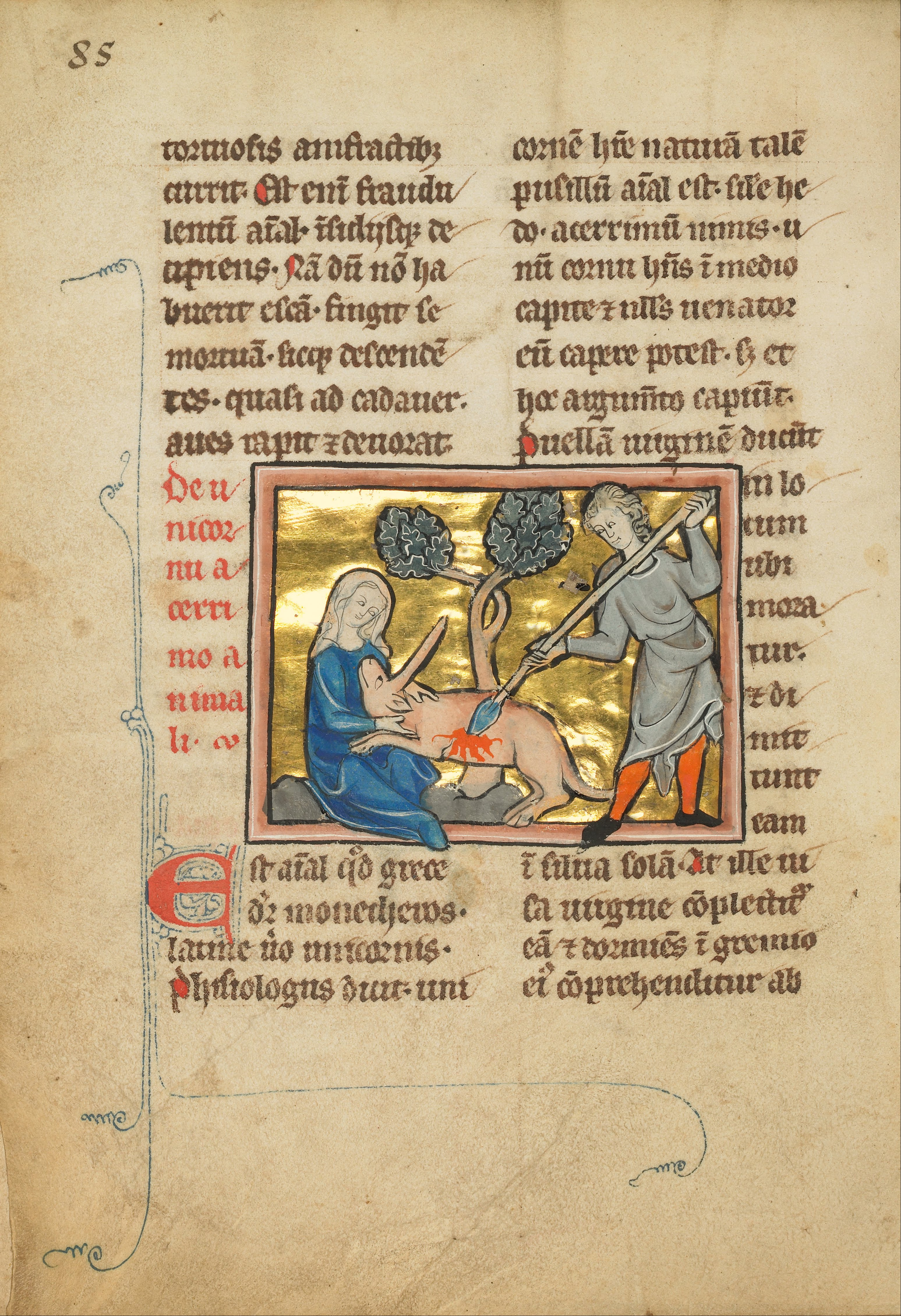
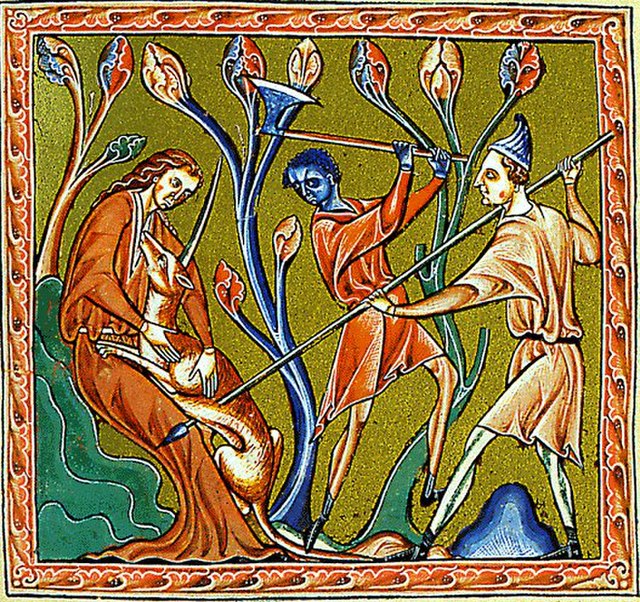
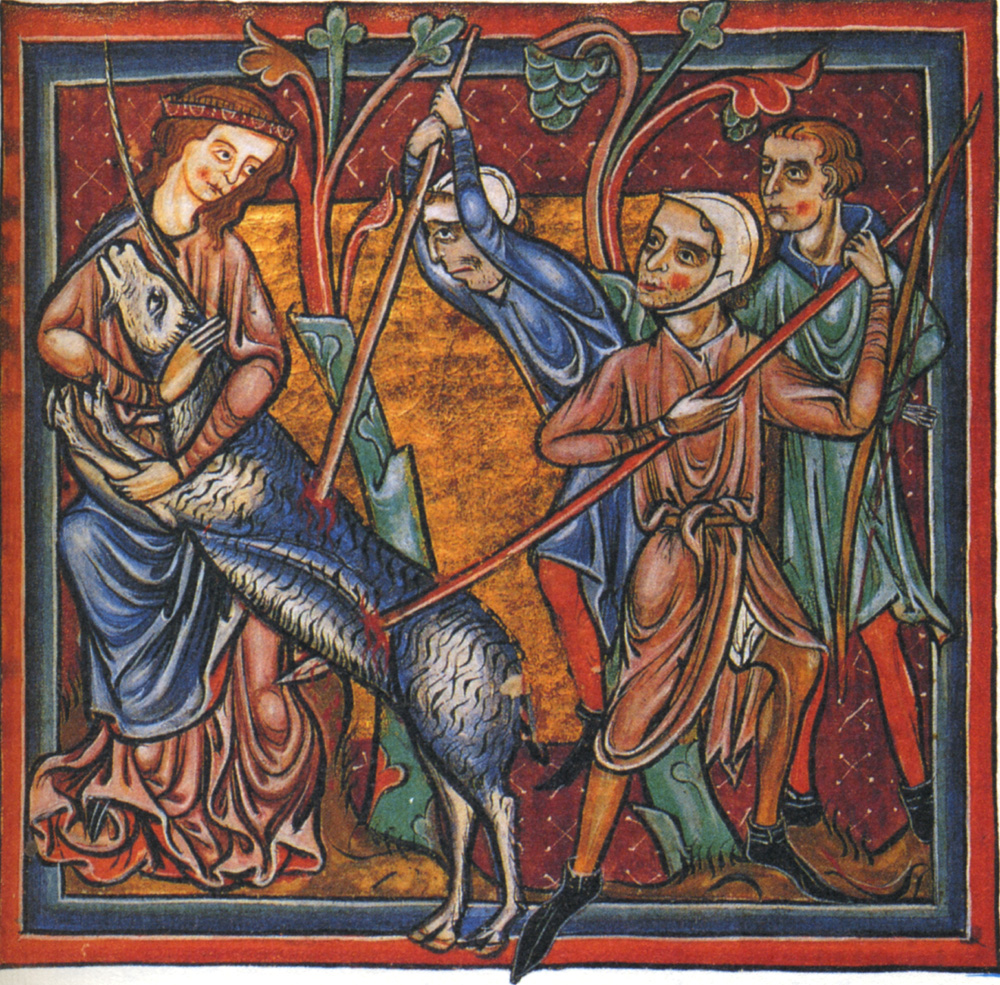
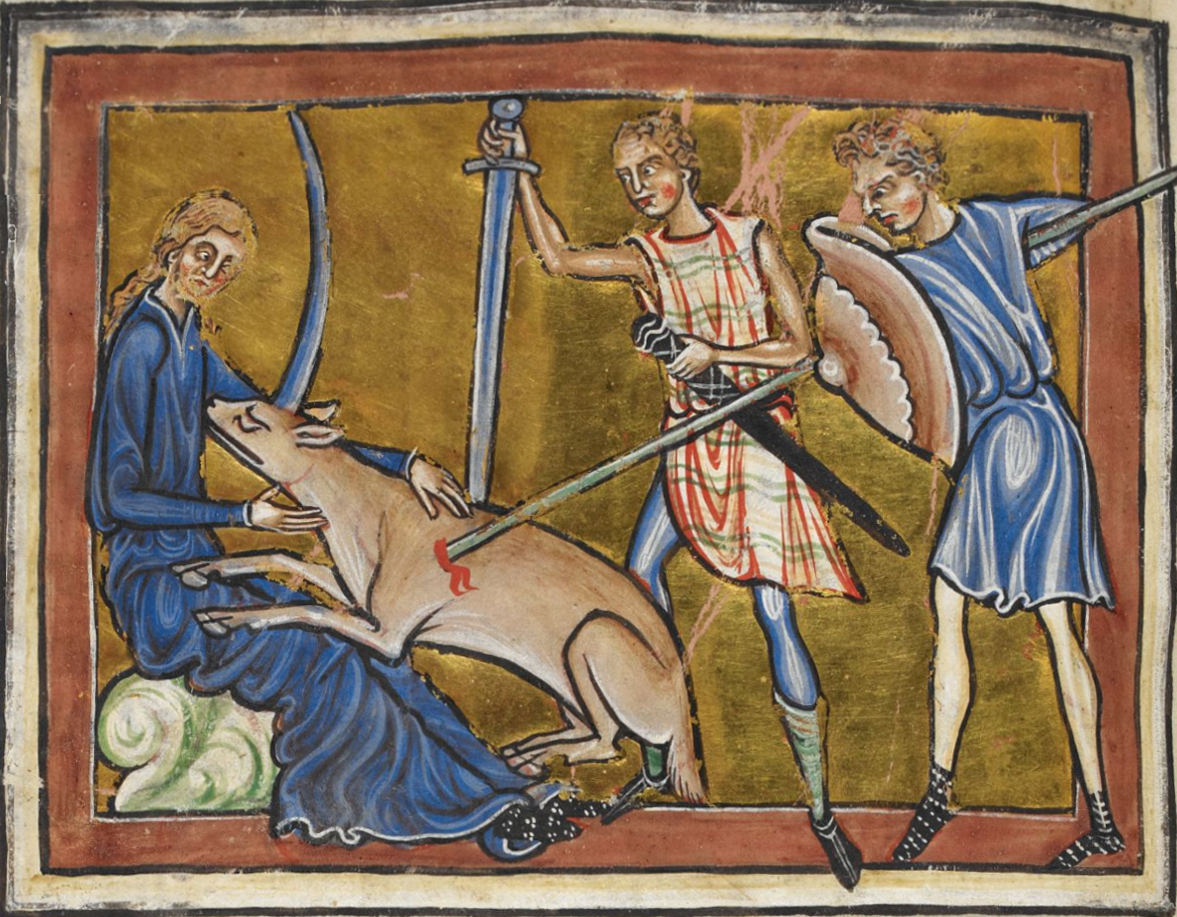
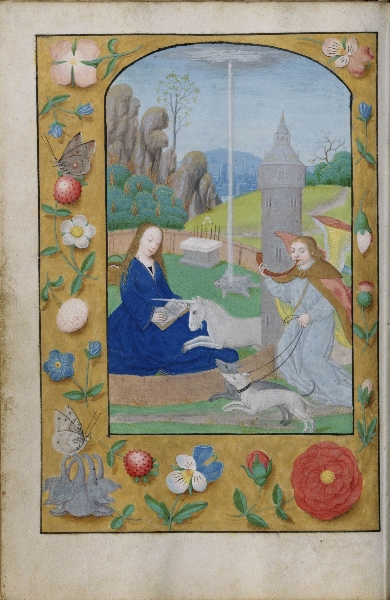
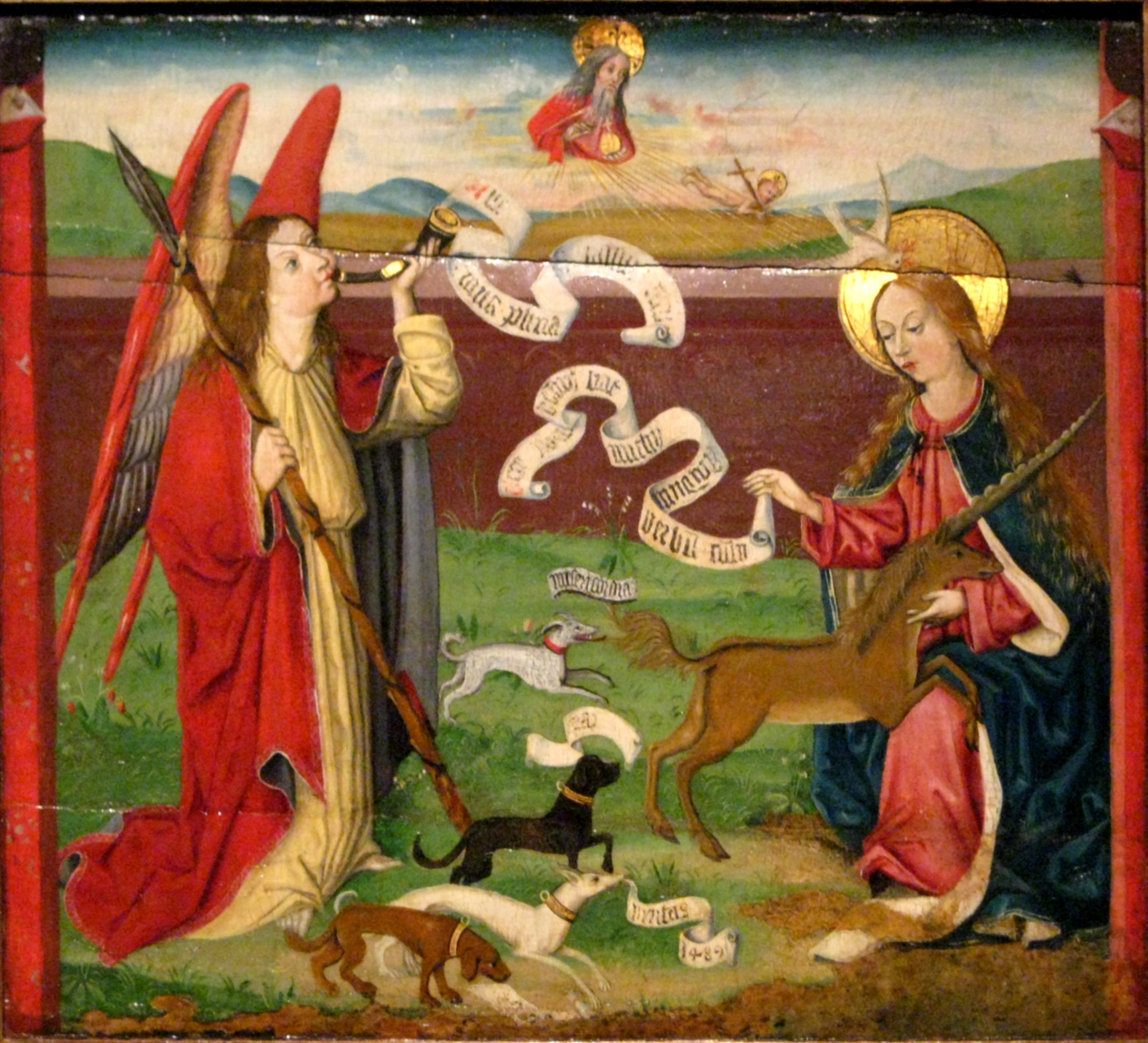
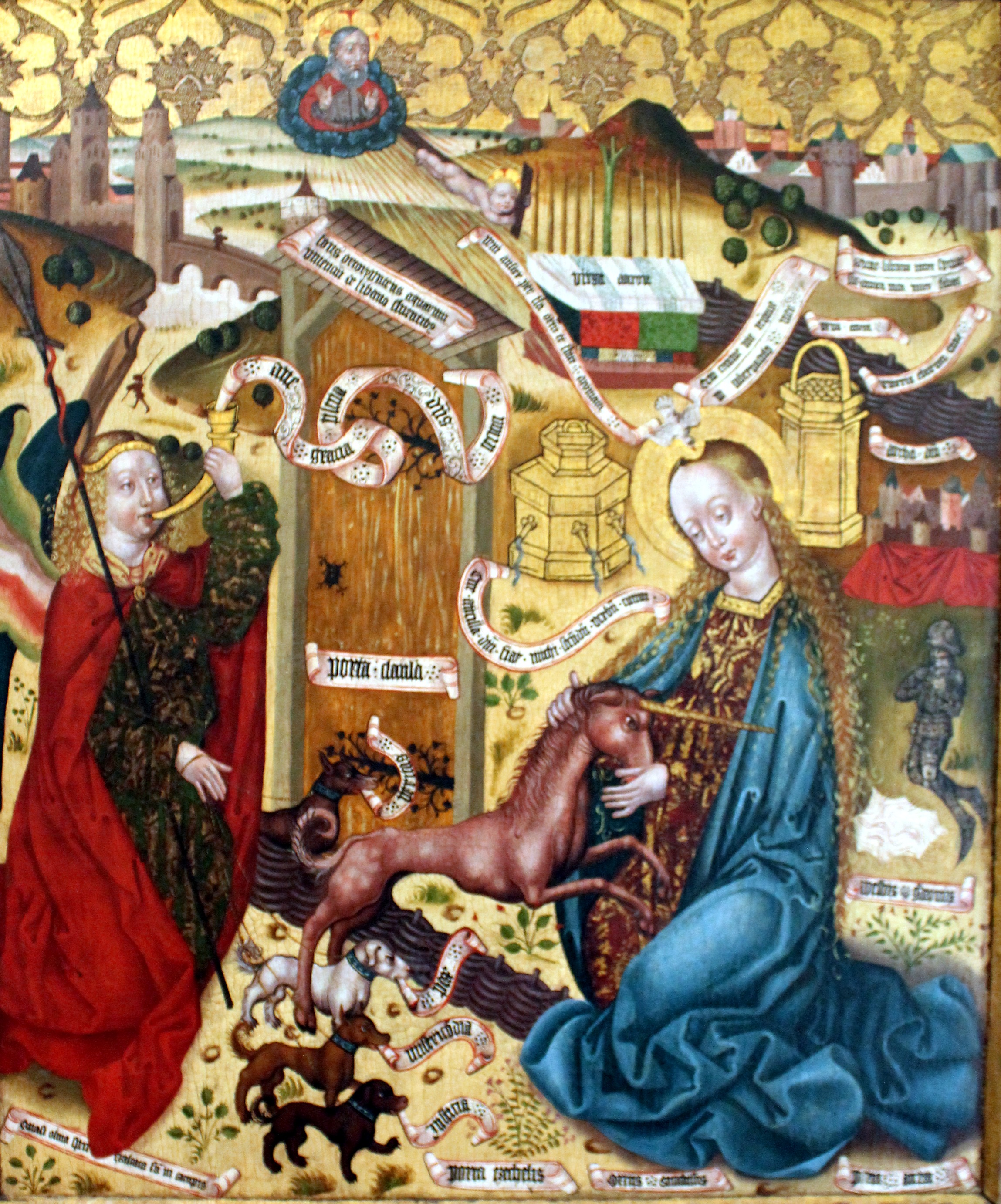
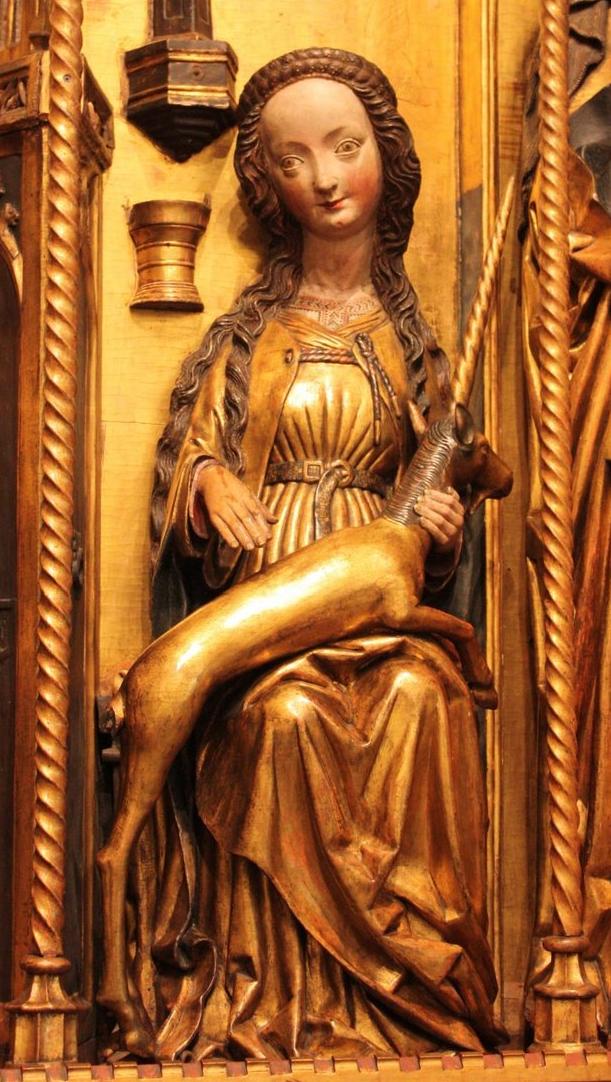
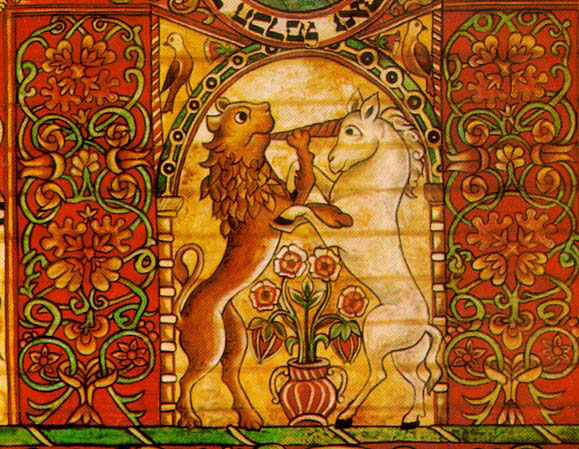
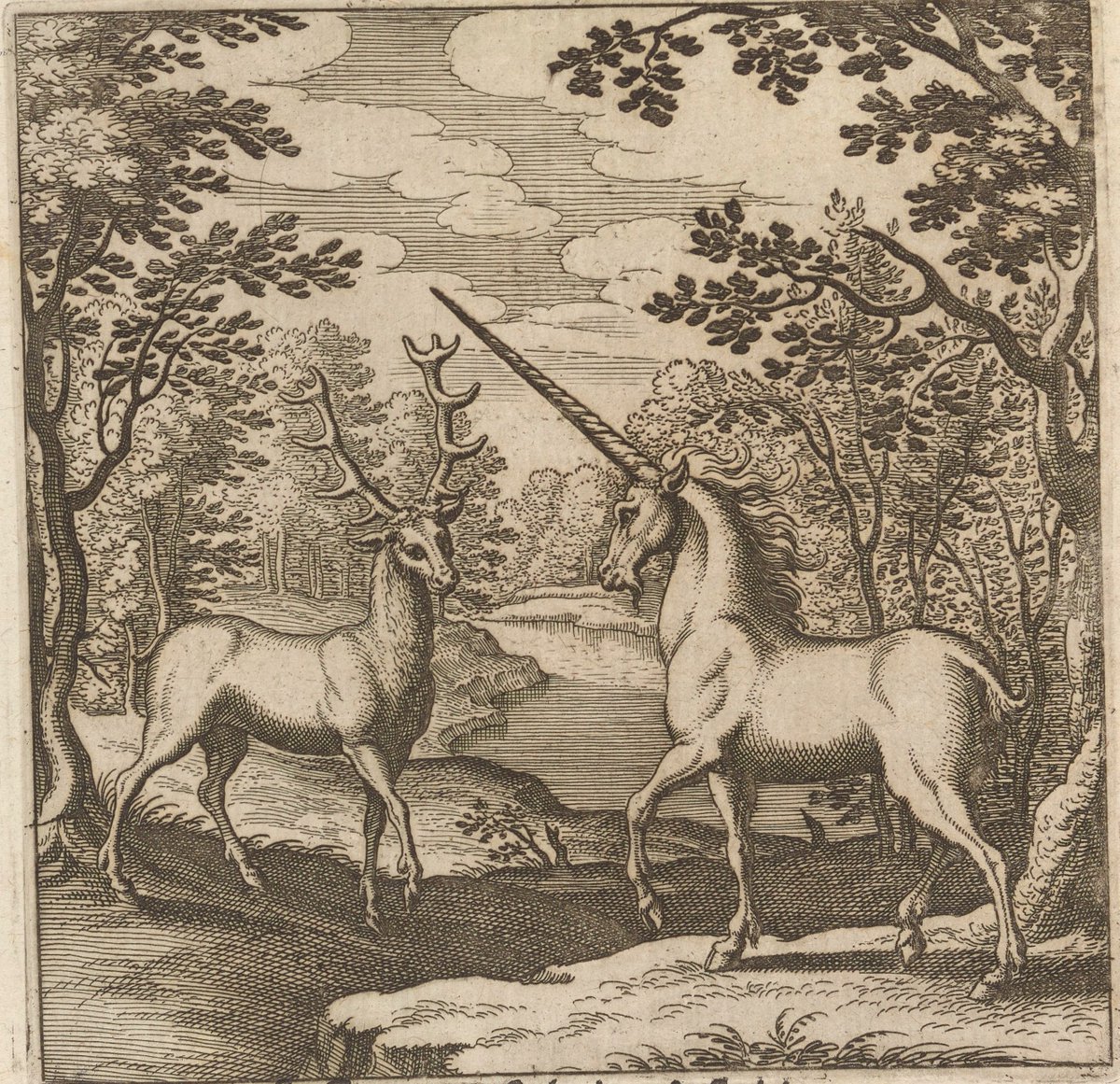
Sections:
- The Bible
- The Early Bestiaries and Natural Histories
- The Church Fathers
- The Middle Ages
- The Renaissance and Early-Modern Period
- The Unicorn Hunt as an Allegory for the Incarnation
- The Unicorn Tapestries
The Bible
In the Hebrew Scriptures, the word תַּחַשׁ (tachash) and derivatives has often been understood as referring to an animal. It has also been interpreted as referring to a color or quality. Tachash appears in Ex 25:5; 26:14; 35:7, 23; 36:19; 39:34; Nm 4:6, 8, 10, 11-12, 14, 25; and Ez 16:10. If it refers to an animal, it is unclear what animal this is. English translations suggest possibilities as different as "badger" and "dolphin." However, the Midrash states the following: "R. Judah said: It was a large pure animal, with a single horn in its forehead and a skin of six different colors that roamed the desert. They captured one of them and from its skin made a covering for the ark. R. Nehemiah contended that it was a miraculous creature He created for that precise moment, and that it disappeared immediately thereafter from earth." (Midrash Tanhuma-Yelammedenu, Terumah, Siman 6, trans. Samuel A. Berman)
The Talmud relates this discussion over the creature: "Rabbi Ela said that Rabbi Shimon ben Lakish said that Rabbi Meir used to say: The taḥash that existed in the days of Moses was a creature unto itself, and the Sages did not determine whether it was a type of undomesticated animal or a type of domesticated animal. And it had a single horn on its forehead, and this taḥash happened to come to Moses for the moment while the Tabernacle was being built, and he made the covering for the Tabernacle from it. And from then on, the taḥash was suppressed and is no longer found." (Talmud, Shabbat 28b, trans. William Davidson)
The animal called רְאֵם (re’em) in the Hebrew Scriptures has had much more influence on Christian unicorn symbolism than the animal called tachash. Jewish tradition has generally not understood the re’em to be a single-horned animal. Indeed, some verses (such as Ps. 22:21) imply that it has more than one horn. Nevertheless, Christian tradition has often identified the re’em as a unicorn.
The word re’em with its derivatives appears nine times in the Hebrew Bible (Nm. 23:22 and 24:8; Dt. 33:17; Job 39:9–10; Ps. 22:21, 29:6, and 92:10; and Is. 34:7). The ancient Greek translation of the Hebrew Bible, the Septuagint (LXX), usually translates re’em as μονόκερως (monokeros or monoceros). Mονόκερως literally means “single-horned,” and is more a description of the animal that the Septuagint translators took the re’em to be than a proper name. It may be that the wild, ox-like animal named re’em in Hebrew was depicted in profile such that it appeared to have only a single horn. The word for the animal in question sometimes appeared in ancient Latin versions of the Bible (such as the old Latin versions and the Vulgate) as unicornis (“single-horned”), though the Latinized Greek word rinoceros (“horned-nosed”) or monoceros itself also occur. Some English translations of the Bible (such as the King James Version) call the animal in question “unicorn.”
|
Septuagint |
Vulgate |
King James Version |
|---|---|---|
|
Nm. 23:22: Θεὸς ὁ ἐξαγαγὼν αὐτοὺς ἐξ Αἰγύπτου· ὡς δόξα μονοκέρωτος αὐτῷ. |
Nm. 23:22: Deus eduxit eum de Aegypto cuius fortitudo similis est rinocerotis. |
Nm. 23:22: God brought them out of Egypt; he hath as it were the strength of an unicorn. |
|
Nm. 24:8: Θεὸς ὡδήγησεν αὐτὸν ἐξ Αἰγύπτου, ὡς δόξα μονοκέρωτος αὐτῷ· ἔδεται ἔθνη ἐχθρῶν αὐτοῦ καὶ τὰ πάχη αὐτῶν ἐκμυελιεῖ καὶ ταῖς βολίσιν αὐτοῦ κατατοξεύσει ἐχθρόν· |
Nm. 24:8: Deus eduxit illum de Aegypto cuius fortitudo similis est rinocerotis devorabunt gentes hostes illius ossaque eorum confringent et perforabunt sagittis. |
Nm. 24:8: God brought him forth out of Egypt; he hath as it were the strength of an unicorn: he shall eat up the nations his enemies, and shall break their bones, and pierce them through with his arrows. |
|
Dt. 33:17: Πρωτότοκος ταύρου τὸ κάλλος αὐτοῦ, κέρατα μονοκέρωτος τὰ κέρατα αὐτοῦ· ἐν αὐτοῖς ἔθνη κερατιεῖ ἅμα ἕως ἀπ᾿ ἄκρου γῆς. αὗται μυριάδες ᾿Εφραΐμ, καὶ αὗται χιλιάδες Μανασσῆ. |
Dt. 33:17: quasi primogeniti tauri pulchritudo eius cornua rinocerotis cornua illius in ipsis ventilabit gentes usque ad terminos terrae hae sunt multitudines Ephraim et haec milia Manasse. |
Dt. 33:17: His glory is like the firstling of his bullock, and his horns are like the horns of unicorns: with them he shall push the people together to the ends of the earth: and they are the ten thousands of Ephraim, and they are the thousands of Manasseh. |
|
Job 39:9–10: Βουλήσεται δέ σοι μονόκερως δουλεῦσαι ἢ κοιμηθῆναι ἐπὶ φάτνης σου; δήσεις δὲ ἐν ἱμᾶσι ζυγὸν αὐτοῦ ἢ ἑλκύσει σου αὔλακας ἐν πεδίῳ; |
Job 39:9–10: Numquid volet rinoceros servire tibi aut morabitur ad praesepe tuum? Numquid alligabis rinocerota ad arandum loro tuo aut confringet glebas vallium post te? |
Job 39:9–10: Will the unicorn be willing to serve thee, or abide by thy crib? Canst thou bind the unicorn with his band in the furrow? or will he harrow the valleys after thee? |
|
Ps. 21:22: Σῶσόν με ἐκ στόματος λέοντος καὶ ἀπὸ κεράτων μονοκερώτων τὴν ταπείνωσίν μου. |
Ps. 21:22: Salva me ex ore leonis et de cornibus unicornium exaudi me! |
Ps. 22:21: Save me from the lion’s mouth: for thou hast heard me from the horns of the unicorns. |
|
Ps. 28:6: Καὶ λεπτυνεῖ αὐτὰς ὡς τὸν μόσχον τὸν Λίβανον, καὶ ὁ ἠγαπημένος ὡς υἱὸς μονοκερώτων. |
Ps. 28:6: Et disperget eas quasi vitulus Libani et Sarion quasi filius rinocerotis. |
Ps. 29:6: He maketh them also to skip like a calf; Lebanon and Sirion like a young unicorn. |
|
Ps. 91:11: Καὶ ὑψωθήσεται ὡς μονοκέρωτος τὸ κέρας μου καὶ τὸ γῆράς μου ἐν ἐλαίῳ πίονι· |
Ps. 91:11: Et exaltabitur quasi monocerotis cornu meum et senecta mea in oleo uberi. |
Ps. 92:10: But my horn shalt thou exalt like the horn of an unicorn: I shall be anointed with fresh oil. |
|
Is. 34:7: Καὶ συμπεσοῦνται οἱ ἁδροὶ μετ᾿αὐτῶν καὶ οἱ κριοὶ καὶ οἱ ταῦροι, καὶ μεθυσθήσεται ἡ γῆ ἀπὸ τοῦ αἵματος καὶ ἀπὸ τοῦ στέατος αὐτῶν ἐμπλησθήσεται. |
Is. 34:7: Et descendent unicornes cum eis et tauri cum potentibus inebriabitur terra eorum sanguine et humus eorum adipe pinguium. |
Is. 34:7: And the unicorns shall come down with them, and the bullocks with the bulls; and their land shall be soaked with blood, and their dust made fat with fatness. |
The Early Bestiaries and Natural Histories
|
Aelian (ca. 175 – ca. 235 AD), De natura animalium, III.41 ἵππους μονόκερως γῆ Ἰνδικὴ τίκτει, φασί, καὶ ὄνους μονόκερως ἡ αὐτὴ τρέφει, καὶ γίνεταί γε ἐκ τῶν κεράτων τῶνδε ἐκπώματα. καὶ εἴ τις ἐς αὐτὰ ἐμβάλοι φάρμακον θανατηφόρον, ὁ πιών, οὐδὲν ἐπιβουλὴ λυπήσει αὐτόν: ἔοικε γὰρ ἀμυντήριον τοῦ κακοῦ τὸ κέρας καὶ τοῦ ἵππου καὶ τοῦ ὄνου εἶναι. |
Aelian (ca. 175 – ca. 235 AD), De natura animalium, III.41 India produces horses with one horn, they say, and the same country fosters asses with a single horn. And from these horns they make drinking-vessels, and if anyone puts a deadly poison in them and a man drinks, the plot will do him no harm. For it seems that the horn both of the horse and of the ass is an antidote to the poison. [Translation by A. F. Scholfield, On the Characteristics of Animals (London: Heinemann, 1958–59).] |
|
Pliny the Elder (ca. AD 23–79), Naturalis Historia, VIII.31 In india et boves solidis ungulis, unicornes, et feram nomine axin hinnulei pelle pluribus candidioribusque maculis, sacrorum liberi patris - (orsaei indi simias candentes toto corpore venantur) - , asperrimam autem feram monocerotem, reliquo corpore equo similem, capite cervo, pedibus elephanto, cauda apro, mugitu gravi, uno cornu nigro media fronte cubitorum duum eminente. hanc feram vivam negant capi. |
Pliny the Elder (ca. AD 23–79), Naturalis Historia, VIII.31 There are in India oxen also with solid hoofs and a single horn; and a wild beast called the axis, which has a skin like that of a fawn, but with numerous spots on it, and whiter; this animal is looked upon as sacred to Bacchus. The Orsaean Indians hunt down a kind of ape, which has the body white all over; as well as a very fierce animal called the monoceros, which has the head of the stag, the feet of the elephant, and the tail of the boar, while the rest of the body is like that of the horse; it makes a deep lowing noise, and has a single black horn, which projects from the middle of its forehead, two cubits in length. This animal, it is said, cannot be taken alive.[Translation by John Bostock and H.T. Riley, The Natural History, (London: Taylor and Francis, 1855).] |
|
The Physiologus Latinus B (ca. second century AD) Francis J. Carmody, ed., Physiologus Latinus Éditions préliminaires versio B (Paris: Librairie E. Droz, 1939), 31–32. XVI. UNICORNIS Est animal quod graece dicitur monosceros, latine uero unicornis. Physiologus dicit unicornem hanc habere naturam: pusillum animal est, simile haedo, acerrimum nimis, unum cornu habens in medio capite. Et nullus omnino uenator eum capere potest; sed hoc argumento eum capiunt: puellam uirginem ducunt in illum locum ubi moratur, et dimittunt eam in siluam solam; at ille uero, mox ut uiderit eam, salit in sinum uirginis, et complectitur eam, et sic comprehenditur, et exhibetur in palatio regis. Sic et dominus noster Iesus Christus, spiritalis unicornis, descendens in uterum uirginis, per carnem ex ea sumptam, captus a Iudaeis, morte crucis damnatus est; de quo Dauid dicit: Et dilectus sicut filius unicornium; et rursum in alio psalmo ipse de se dicit: Et exaltabitur sicut unicorunis cornu meum. Et Zacharias dicit: Suscitauit eum cornu salutis in domo Dauid pueri sui. Et in Deuteronomio Moyses benedicens tribum Ioseph: Primitiuos tauri species eius, cornua eius tamquam cornua unicornis. Quod autem unum cornu habet in capite significat hoc quod dicit saluator: Ego et pater unum sumus. Caput enim Christi, deus, secundum apostolum. Acerrimum uero quod dicit eum, id est quod neque principatus, neque potestates, non throni neque dominationes intelligere potuerunt, nec infernus tenere ualuit. Quod autem dicitur pusillum animal: propter incarnationis eius humilitatem; dicente ipso: Discite a me, quia mitis sum et humilis corde. In tantum autem acerrimus, ut nec ille subtilissimus diabolus intelligere aut inuestigare potuit, sed sola uoluntate patris descendit in uterum uirginis Mariae pro nostram salutem: Et uerbum caro factum est, et habitauit in nobis. Quod autem est similis haedo unicornis -- et saluator noster secundum apostolum: Factus est in similitudinem carnis peccati, et de peccato damnauit peccatum in carne. Bene ergo dictum est de unicorne. |
The Physiologus Latinus B (ca. second century AD) Francis J. Carmody, ed., Physiologus Latinus Éditions préliminaires versio B (Paris: Librairie E. Droz, 1939), 31–32. XVI.UNICORN There is an animal called in Greek monoceros and in Latin unicornis. The Naturalist says that the unicorn possesses this nature: It is a small animal, like a goat, extremely fierce, having one horn in the middle of its head. And no hunter at all can capture it. But with the following method they do capture it. They take a young virgin to the place it visits and send her into the forest alone. Now as soon as it sees her, it leaps into the virgin's bosom and embraces her. And in this way it is caught and put on display in the king's palace. So, too, our Lord Jesus Christ, the spiritual unicorn, coming down to the Virgin's womb through the flesh he took from her, was captured by the Jews and condemned to death on a cross. Of him David says, And the beloved like the son of unicorns. And again in another psalm he says of himself, And my horn shall be exalted like a unicorn's. And Zachariah says, He has raised him up as a horn of salvation in the house of David his servant. And in Deuteronomy Moses, blessing the tribe of Joseph, says, His appearance like the first-born of a bull, his horns like the horns of a unicorn. Now the fact that it has one horn on its head signifies what the savior says, I and the Father are one. For the head of Christ is God according to the Apostle. That he calls it extremely fierce means that neither principalities, nor powers, nor thrones, nor dominations could understand [him], nor was hell able to hold him. That it is called a small animal is due to the humility of his Incarnation, as he says, Learn from me, for I am meek and humble of heart. Now he was so fierce that not even the devil in his utmost subtlety could understand or search this out, but by the Father's will alone did he come down to the womb of the Virgin Mary for our salvation. And the Word became flesh and dwelt among us. And that the unicorn is like a goat means that, our savior, too, according to the Apostle, Came to be in the likeness of the flesh of sin and for sin condemned sin in the flesh. Well said, then, of the unicorn. |
|
The Physiologus Latinus Y (ca. second century AD) XXXV. DE MONOCERATON Moyses de monoceraton in Deuteronomio dixit, benedicens Ioseph: Primitivus tauri species eius, cornua unicornui cornua eius. Monoceras, hoc est unicornis, hanc naturam habet: pusillum animal est, hedo similis, acerrimum nimis, unum cornum habet in medio capite. Non potest ei venator appropiare, propter quod valde fortissimum est. Quomodo ergo eum venantur? virginem castam proiciunt ante eum; exilit in sinum virginis, et illa calefacit eum, et nutrit illud animal; et tollit in palatium regum. Unum cornum autem habet, propter quod dixit salvator: Ego et pater unum sumus. Suscitavit enim nobis cornu salutis, in domo David pueri sui; veniens de caelo, venit in utero virginis Mariae: Dilectus sicut filius unicorniorum, sicut David in psalmo. |
The Physiologus Latinus Y (ca. second century AD) XXXV. ON THE MONOCEROS Moses spoke of the monoceros in Deuteronomy when blessing Joseph: His appearance like the first-born of a bull, his horns the horns of a unicorn. The monoceros (unicorn) possesses this nature: It is a small animal, like a goat, extremely fierce; it has one horn in the middle of its head. A hunter cannot get close to it due to its being so very strong. How then do they hunt it? They send a chaste virgin before it. It goes out to the virgin's bosom and she warms and nurses the animal. And they take it to the kings' palace. Now it has one horn, for which reason the savior said, I and the Father are one. For he has raised up for us a horn of salvation in the house of David his servant, coming down from heaven, he came to the womb of the Virgin Mary, beloved like the son of unicorns, as David says in the psalm |
|
Isidore of Seville (ca. 560–636), Etymologiae, XII.2.12–13 Rhinoceron a Graecis vocatus. Latine interpretatur in nare cornu. Idem et monoceron, id est unicornus, eo quod unum cornu in media fronte habeat pedum quattuor ita acutum et validum ut quidquid inpetierit, aut ventilet aut perforet. Nam et cum elephantis saepe certamen habet, et in ventre vulneratum prosternit. Tantae autem esse fortitudinis ut nulla venantium virtute capiatur; sed, sicut asserunt qui naturas animalium scripserunt, virgo puella praeponitur, quae venienti sinum aperit, in quo ille omni ferocitate deposita caput ponit, sicque soporatus velut inermis capitur. |
Isidore of Seville (ca. 560–636), Etymologiae, XII.2.12–13 Called "Rhinoceros" by the Greeks, which in Latin means "horn on the nose." The same [animal] is also called "monoceros" (unicorn), from the fact that, among the four-footed beasts, it has one horn in the middle of its forehead. [This horn is] so sharp and strong that whatever it strikes it either impales or pierces. For it is always fighting with elephants and drops down in order to wound them in the belly. It is of such great ferocity as not to be captured by the might of any hunters. But, as those who have written on the characteristics of animals assert, a young maiden girl is brought before it and she opens her bosom to it when it comes to her, in which it lays its head, leaving aside all its fierceness, and this is how — lulled and as it were unarmed — it is captured. |
The Church Fathers
The Church Fathers assign a variety of meanings to the unicorn, such as the Lord's cross, the people of God, or Christ himself.
|
Justin Martyr (ca. 100–ca.165) Dialogus contra Tryphonem Iudaeum, 91 (PG 6:692–693): Καὶ γὰρ δι' ἄλλου μηνύων τὴν ἰσχὺν τοῦ μυστηρίου τοῦ σταυροῦ ὁ θεὸς διὰ Μωυσέως εἶπεν ἐν εὐλογίᾳ, ἣν εὐλόγει τὸν Ἰωσήφ· Ἀπὸ εὐλογίας κυρίου ἡ γῆ αὐτοῦ, ἀπὸ ὡρῶν οὐρανοῦ καὶ δρόσων, καὶ ἀπὸ ἀβύσσου πηγῶν κάτωθεν, καὶ καθ' ὥραν γεννημάτων ἡλίου τροπῶν, καὶ ἀπὸ συνόδων μηνῶν, καὶ ἀπὸ κορυφῆς ὀρέων ἀρχῆς, καὶ ἀπὸ κορυφῆς βουνῶν, καὶ ποταμῶν ἀεννάων, καὶ καρπῶν γῆς πληρώσεως. καὶ τᾶ δεκτὰ τῷ ὀφθέντι ἐν τῇ βάτῳ ἔλθοισαν ἐπὶ κεφαλὴν Ἰωσὴφ καὶ ἐπὶ κορυφῆς. Δοξασθεὶς ἐν ἀδελφοῖς πρωτότοκος, ταύρου τὸ κάλλος αὐτοῦ, κέρατα μονοκέρωτος τὰ κέρατα αὐτοῦ, ἐν αὐτοῖς ἔθνη κερατιεῖ ἅμα ἕως ἀπὸ ἄκρου τῆς γῆς. Μονοκέρωτος γὰρ κέρατα οὐδενὸς ἄλλου πράγματος ἢ σχήματος ἔχοι ἄν τις εἰπεῖν καὶ ἀποδεῖξαι, εἰ μὴ τοῦ τύπου ὃς τὸν σταυρὸν δείκνυσιν. ὄρθιον γὰρ τὸ ἕν ἐστι ξύλον, ἀφ' οὗ ἐστι τὸ ἀνώτατον μέρος εἰς κέρας ὑπερηρμένον, ὅταν τὸ ἄλλο ξύλον προσαρμοσθῇ, καὶ ἑκατέρωθεν ὡς κέρατα τῷ ἑνὶ κέρατι παρεζευγμένα τὰ ἄκρα φαίνηται· καὶ τὸ ἐν τῷ μέσῳ πηγνύμενον ὡς κέρας καὶ αὐτὸ ἐξέχον ἐστίν, ἐφ' ᾧ ἐποχοῦνται οἱ σταυρούμενοι, καὶ βλέπεται ὡς κέρας καὶ αὐτὸ σὺν τοῖς ἄλλοις κέρασι συνεσχηματισμένον καὶ πεπηγμένον. καὶ τὸ Ἐν αὐτοῖς ἔθνη κερατιεῖ ἅμα ἕως ἀπ' ἄκρου τῆς γῆς δηλωτικόν ἐστι τοῦ νῦν γεγενημένου πράγματος ἐν πᾶσι τοῖς ἔθνεσι. Κερατισθέντες γάρ, τοῦτ' ἔστι κατανυγέντες, οἱ ἐκ πάντων τῶν ἐθνῶν διὰ τούτου τοῦ μυστηρίου εἰς τὴν θεοσέβειαν ἐτράπησαν ἀπὸ τῶν ματαίων εἰδώλων καὶ δαιμόνων |
Justin Martyr (ca. 100–ca.165) Dialogus contra Tryphonem Iudaeum, 91 (PG 6:692–693): There is yet another reason why God, pointing to the mystery of the cross through Moses, says in the blessing whereby he blesses Joseph, His land from the Lord's blessing, from the times of the heavens and the dew, and from the depth of the springs below and pure waters, the seeds of the sun's turning, and the joining of months and the peak of ancient mountains and the peak of hills and everlasting rivers, and of the fullness of the fruits of the earth, and what is acceptable to him who was seen in the bush—may these come upon the head and crown of Joseph. Borne up with glory among his brothers, his beauty the first-born of a bull, his horns the horns of a unicorn. On them he will upset the nations together even from the end of the earth. For no one can say or show that the unicorn's horns are found in any other thing or figure than in that which shows the cross. For it is one upright beam from which the highest part is lifted up as a horn when another beam is fixed to it, and the extremities jutting out from there seem like horns affixed to the one horn. And that which is fixed in the middle, to hold those who are crucified on it, itself sticks out like a kind of horn and shows the likeness of a horn fitted and fixed to the other horns. The passage with these horns he will assail the nations even from the end of the earth, then, shows what we see has happened today among all the nations. For assailed by the horn, that is pierced through by this mystery, men from all the nations have been converted from empty idols and demons to the worship of God. |
|
Tertullian (ca. 155–ca. 220) Adversus Marcionem, III.18 (CCSL 1:TODO): Ioseph et ipse Christum figuraturus (nec hoc solo, ne demorer cursum, quod persecutionem a fratribus passus est ob dei gratiam, sicut et Christus a Iudaeis carnaliter fratribus) cum benedicitur a patre etiam in haec verba, Tauri decor eius, cornua unicornis cornua eius, in eis nationes ventilabit pariter ad summum usque terrae: non utique rhinoceros destinabatur unicornis nec minotaurus bicornis, sed Christus in illo significabatur, taurus ob utramque dispositionem, aliis ferus ut iudex, aliis mansuetus ut salvator, cuius cornua essent crucis extima. Nam et in antenna, quae crucis pars est, extremitates cornua vocantur; unicornis autem medius stipitis palus. Hac denique virtute crucis et hoc more cornutus universas gentes et nunc ventilat per fidem, auferens a terra in caelum, et tunc per iudicium ventilabit, deiciens de caelo in terram. […] Si adhuc quaeris dominicae crucis praedicationem, satis iam tibi potest facere vigesimus primus psalmus, totam Christi continens passionem, canentis iam tunc gloriam suam: Foderunt, inquit, manus meas et pedes, quae propria atrocitas crucis. Et rursus, cum auxilium patris implorat, Salvum, inquit, fac me ex ore leonis, utique mortis, et de cornibus unicornis humilitatem, de apicibus scilicet crucis, ut supra ostendimus. Adversus Iudaeos, X (CCSL 2:TODO): Ioseph et ipse Christum figuratus vel hoc solo, ne cursum demorer, quod persecutionem a fratribus passus est et venumdatus in Aegyptum ob dei gratiam, sicut et Christus ab Israele, carnaliter a fratribus venumdatus, a Iuda cum traditur. Nam et benedicitur a patre in haec verba Ioseph: Tauri decor eius, cornua unicornis cornua eius; in eis nationes ventilabit pariter ad summum usque terrae. Non utique rhinoceros destinabatur unicornis nec minotaurus bicornis, sed Christus in illo significabatur, taurus ob utramque dispositionem, aliis ferus ut iudex aliis mansuetus ut salvator, cuius cornua essent crucis extima — nam et in antemna navis quae crucis pars est hoc extremitates eius vocantur —, unicornis autem medio stipite palus. Hac denique virtute crucis et hoc more cornutus universas gentes et nunc ventilat per fidem auferens a terra in caelum et tunc ventilabit per iudicium deiciens de caelo in terram. […] Si adhuc quaeris dominicae crucis praedicationes, satis iam poterit tibi facere vicesimus primus psalmus totam Christi continens passionem canentis iam tunc gloriam suam: Foderunt, inquit, manus meas et pedes, quae propria est atrocitas crucis. Et rursus, cum auxilium patris implorat: Salvum me fac, inquit, ex ore leonis, utique mortis, et de cornibus unicornuorum humilitatem meam, de apicibus scilicet crucis, ut supra ostendimus. Quam crucem nec ipse David passus est nec ullus regum Iudaeorum, ne putetis alterius alicuius prophetari passionem quam eius qui solus a populo tam insigniter crucifixus est. |
Tertullian (ca. 155–ca. 220) Adversus Marcionem, III.18 (CCSL 1:TODO): Joseph, too, prefigured Christ (and, not to slow our progress, not only in the fact that he suffered persecution from his brothers on account of God's grace, just as Christ did from the Jews who were his brothers in the flesh) when he is blessed by his father also in these words, A bull's splendor is his, his horns the horns of a unicorn, on them he will throw the nations into upset all alike even to the earth's utmost. It was, then, not a one-horned rhinoceros nor a two-horned minotaur, but Christ who was signified in this: a bull because of both dispositions, fierce to some as judge, meek to others as savior, whose horns would be the tips of the cross. For at the top point, too, which is part of the cross, the extremities are called horns, and the unicorn is the middle pole rising from the trunk. Finally, by this power of the cross and in this way horned, even now does he upset all the nations through faith, taking them from earth to heaven, and then he will cause upset by his judgment, casting down from heaven to earth. […] If you still seek predictions of the Lord's cross, the twenty-first psalm will at last be enough for you, containing Christ's whole passion, as the one singing his glory then says, They have pierced my hands and my feet, a horror proper to the cross. And again, when he implores the Father's help, Save me from the lion's mouth (death) and my lowliness from the horns of the unicorn (the points of the cross), as we showed above. Adversus Iudaeos, X (CCSL 2:TODO): Joseph, too, prefigured Christ, not to slow our progress, at least in the fact that he suffered persecution from his brothers and was sold into Egypt by God's grace, just as Christ was sold by Israel, his brothers in the flesh, when handed over by Judas. For he is also blessed by his father also in these words, A bull's splendor is his, his horns the horns of a unicorn, on them he will throw the nations into upset all alike even to the earth's utmost. It was, then, not a one-horned rhinoceros nor a two-horned minotaur, but Christ who was signified in this: a bull because of both dispositions, fierce to some as judge, meek to others as savior, whose horns would be the tips of the cross. For at the ship's top point, too, which is part of the cross, the extremities are called this, and the unicorn is the middle pole rising from the trunk. Finally, by this power of the cross and in this way horned, even now does he upset all the nations through faith, taking them from earth to heaven, and then he will cause upset by his judgment, casting down from heaven to earth. […] If you still seek predictions of the Lord's cross, the twenty-first psalm will at last be enough for you, containing Christ's whole passion, as the one singing his glory then says, They have pierced my hands and my feet, a horror proper to the cross. And again, when he implores the Father's help, Save me from the lion's mouth (death) and my lowliness from the horns of the unicorn (the points of the cross), as we showed above. Neither David nor any of the kings of the Jews suffered this cross, lest you think the prophecy is of another than he who alone was crucified by the people in such a notable way. |
|
Theodoret of Cyrus (ca. 393–ca. 458) Quaestiones in Numeros, 43 (PG 80:392–93)
Τί ἐστιν, Ὡς δόξα μονοκέρωτος αὐτῷ; |
Theodoret of Cyrus (ca. 393–ca. 458) Quaestiones in Numeros, 43 (PG 80:392–93)
What is His glory is like that of a unicorn? |
|
Clement of Alexandria (ca. 150–ca. 215) Paedagogus, I.5 (PG 8:269) Παῖδες οὖν εἰκότως οἱ θεὸν μόνον πατέρα ἀφελεῖς καὶ νήπιοι καὶ ἀκέραιοι, οἱ κεράτων μονοκερώτων ἐρασταί. |
Clement of Alexandria (ca. 150–ca. 215) Paedagogus, I.5 (PG 8:269) They are properly children, then, who acknowledge one God as Father, child-like and simple, lovers of the horns of unicorns. |
|
Gregory of Nyssa (ca. 335–ca. 395) Oratio in diem natalem Christi et in infantes qui in Bethlehem occisi sunt ab Herode (dubious authenticity) (PG 46:1128–29): Ἀλλ', ἐπειδὴ τῆς ἁμαρτίας ἐπεισελθούσης ἐφράγη τῶν τῇ κακίᾳ κατειλημμένων τὰ στόματα, καὶ κατεσιγὰσθη φωνὴ ἀγαλλιάσεως, καὶ διεσπάσθη τῶν ἑορταξόντων ἡ συμφωνία, τῆς ἀνθρωπίνης κτίσεως οὐ συνεορταζούσης τῇ ὑπερκοσμίῳ φύσει, διὰ τοῦτον ἦλθον αἱ τῶν προφητῶν καὶ ἀποστόλων σάλπιγγες, ἅς κερατίνας ὁ Νόμος φησὶ, διὰ τὸ εἶναι αὐτῶν τὴν κατασκευὴν ἐκ τοῦ ἀληθινοῦ μονοκέρωτος. |
Gregory of Nyssa (ca. 335–ca. 395) Oratio in diem natalem Christi et in infantes qui in Bethlehem occisi sunt ab Herode (dubious authenticity) (PG 46:1128–29): But because when sin broke onto the scene the mouths of those who had been conquered by malice were shut up, the voice of exultation had fallen silent, and the harmony of those celebrating the feast days had been disrupted, because the human creature did not agree with the super-worldly nature in the act of celebrating, the throngs of prophets and apostles came, which the Law refers to as having horns, since they came to be such from the one true unicorn. |
The Middle Ages
|
Rabanus Maurus (ca. 780–856) De universo (PL 111:220–21) Rhinocerota graece vocatus, latine interpretatur, in nare cornu. Idem et monoceros, id est, unicornis, eo quod unum cornu in media fronte habeat pedum quatuor, ita acutum et validum, ut quidquid impetierit, aut ventilet aut perforet. Nam et cum elephante semper certamen habet, et in ventre vulneratum prosternit. Tantae autem fortitudinis esse dicitur, ut nulla venantium virtute capiatur: sed, sicut hi asserunt, qui describendis naturis animalium laboriosa investigatione sudaverunt, virgo ei puella proponitur, quo venienti illa sinum aperit, in quo ille, omni ferocitate postposita, caput deponit, sicque soporatus, ab eis, a quibus capi quaeritur, repente velut inermis invenitur. Buxei quoque coloris esse describitur. Qui etiam cum elephantis quando certamen aggreditur, eo cornu, quod in nare singulariter gestat, ventrem adversantium ferire perhibetur, ut cum ea, quae molliora sunt vulnerat, impugnantes se facile sternat. Potest ergo per hunc rhinocerotem vel monocerotem scilicet unicornem ille populus intelligi, qui dum de accepta lege non opera sed solam inter cunctos homines elationem sumpsit, quasi inter caeteras bestias cornu singulare gestavit. Unde passionem suam Dominus, Propheta canente, pronuntians ait: Libera me de ore leonis, et a cornibus unicornium humilitatem meam. Tot quippe in illa gente unicornes vel certe rhinocerotes exstiterunt, quot contra praedicamenta veritatis de legis operibus singulari et fatua elatione confisi sunt. Beato igitur Iob sanctae Ecclesiae typum tenenti dicitur: Nunquid volet rhinoceros servire tibi? Ac si apertius dicatur: Nunquid illum populum, quem superbire in nece fidelium stulta sua elatione consideras, sub iure tuae praedicationis inclinas? subaudis, ut ego, qui et contra me illum singulari cornu extolli conspicio, et tamen mihi, cum voluero, protinus subdo. Rhinocerotem ergo Paulo Apostolo per similitudinem comparare possumus, qui prius persecutor et blasphemus exstitit, sicut de eo scriptum est: Saulus adhuc spirans minarum et caedis in discipulos Domini, accessit ad principem sacerdotum, et petiit ab eo epistolas in Damascum ad synagogas: ut si quos invenisset huius vitae viros ac mulieres, vinctos perduceret in Ierusalem. Qui divinae legis eruditione praeditus dum aliorum ingluviem redarguit, cornu elephantis in ventrem ferit. In ventrem quippe elephantos percusserat, cum dicebat: Multi ambulant, quos saepe dicebam vobis, nunc autem et flens dico, inimicos crucis Christi, quorum finis interitus, quorum deus venter est, et gloria in confusione ipsorum. Et rursum: Huiusmodi, inquit, Christo Domino non serviunt, sed suo ventri. Cornu suo igitur rhinoceros iste non iam homines, sed bestias percutit, quando illo Paulus doctrinae suae fortitudine nequaquam perimendos humiles impetit, sed superbos ventris cultores occidit. Quae ergo in Paulo scripta cognovimus, superem, ut facta et in aliis credamus. Multi quippe ad humilitatis gratiam ex illius populi elatione conversi sunt, quorum saevitiam Dominus dum sub iugo inspirati timoris edomuit, nimirum rhinocerotis sibi fortitudinem subegit. Rhinoceros Christus Dominus potest intelligi propter invictam fortitudinem, ut in Deuteronomio: Cuius fortitudo similis est rhinocerotis. Rhinoceros, ut supra diximus, fortes quoque sive potestates saeculi huius in Iob: Nunquid volet rhinoceros servire tibi? Monoceros, hoc est, unicornis, Christus est, ut in psalmo: Et dilectus sicut filius unicornium, id est, singularis potentiae, et unum sanctorum regnum. Unicornis superbi vel unum habentes testamentum, ut in psalmo: Et a cornibus unicornium humilitatem meam. |
Rabanus Maurus (ca. 780–856) De universo (PL 111:220–21) Called rhinoceros in Greek, this means in Latin horn on the nose. This is the same as the monoceros (unicorn), due to its having one horn in the middle of its forehead, four feet, so sharp and strong that whatever it strikes it either shatters or pierces. For it also always has a conflict with the elephant and wounds it in the belly, knocking it to the ground. Now it is said to have such strength that no hunters' might can capture it. But, as they who have labored with toilsome research in the description of animal natures assert, a young virgin is put before it and when it comes to her she invites it to her bosom where, leaving aside all fierceness, it lays its head and, thus drowsing, is suddenly found unarmed by those who seek its capture. It is also described as being the color of boxwood. And when it goes to fight with elephants the report is that it also strikes the belly of its adversaries with that horn that it uniquely bears on its nose, so that when it wounds what is softer it easily topples its enemies. Thus, by the rhinoceros or monoceros (unicorn) can be understood the people who took from the law they had received not works but only elation among all human beings, similar to having borne a unique horn among other beasts. Hence, as the Prophet sings, the Lord announces his passion, saying, Free me from the mouth of the lion and my lowliness from the horns of unicorns. For indeed in that race have existed as many unicorns or certainly rhinoceroses as those who have acted against the preachings of the Truth, placing their confidence in the works of the law and their vain, unique elation. To blessed Job, then, serving as a type of the Church, it is said, Will the rhinoceros be willing to serve you? As if openly saying, “Will you subdue by the law of your preaching the people that you consider to be proud of their killing the faithful in their foolish elation?” You hear implied, as I do, “[the people] that I also see raising that unique horn against me and yet that I straightaway make subject to myself when I will.” Thus we can compare the rhinoceros to the Apostle Paul by way of resemblance, since he was first a persecutor and blasphemer, as it is written of him: Saul, still breathing threats and slaughter against the Lord's disciples, approached the high priest and asked for letters from him to the synagogues for Damascus, so that if he found any men or women belonging to this way he might bring them captive to Jerusalem. Endowed with learning in the divine law, he rebuts the consuming glut of others, thrusting his horn into the elephant's belly. He did indeed strike elephants in the belly when he said, Many walk, of whom I have often spoken to you, and now I say it in tears, as enemies of the cross of Christ, whose end is destruction, whose god is their belly, and their glory is in confusion. And again, This sort, he says, do not serve Christ the Lord but instead their belly. Thus this rhinoceros no longer strikes men but beasts with its horn, when Paul in the might of his doctrine urges the humble not to be cut down but slays the proud who worship their belly. And so to conclude, in these writings of Paul we know as facts what we believe in others. For many have been converted to the grace of humility from the elation of that people, whose cruelty the Lord tamed under the yoke of inspired fear, that is he subjected the rhinoceros's strength to himself. Christ the Lord can be understood as the rhinoceros because of his unconquered strength, as it says in Deuteronomy, Whose strength is like that of the rhinoceros. The rhinoceros, as we said above, is also the mighty or powerful of this age, as it says in Job, Will the rhinoceros be willing to serve you? The monoceros (unicorn) is Christ, as it says in the psalm, And the beloved like the son of unicorns, i.e., of unique power and one kingdom of the holy. The unicorn is the proud or those who have one testament, as it says in the psalm, And my lowliness from the horns of unicorns. |
|
Albert the Great, OP (ca. 1200–1280) De animalibus, XII.3.7 (ed. Stadler 1:890–92) Sicut autem iam ante diximus natura multos modos vigorum et defensionum dat animalibus, et aliquando plures modos congerit in unum et idem animal: propter quod quaedam animalia et calces soleatas et cornua habent sicut asinus Indicus. Et quia natura dextri valde differens est a natura sinistri, aliquando sunt duo cornua in capite animalis, et aliquando unum solum, sicut asinus Indicus qui habet unicum in nare, et animal quod quidam antiquorum archos quasi principem vocaverunt, quod nos unicornem Latine et rynnocerontem Graece vocamus, habet unum cornu maximae quantitatis et solidum sicut cornu cervinum, cuius mensuram ego mensuravi decem pedes excedere in longitudine: et dyameter eius in radice plus habuit quam palmum et dimidium. Quando autem animal habet cornu unum, hoc locatur in medio capitis eo quod medium capitis sive in fronte sit sive in sincipite sive etiam in nare, medius et communis terminus est duorum extremorum laterum. [...] Melius igitur fecit in capite ponendo, et sicut non invenitur animal habens sotularem corneum integrum habens cornu nisi asinus Indicus, eo quod materia cornuum descendit ad pedes, propter quod etiam asinus habet unum tantum: ita non invenitur animal fissi pedis habens cornu unicum nisi unicornis: sed cornu suum est adeo ingens et longum, quod materia duobus non sufficit. De animalibus, XXII.2.1 (ed. Stadler 2:1426) Unicornis est animal moderatae quantitatis respectu suae fortitudinis, buxei coloris et fissae in duo ungulae pedis, in montibus et desertis habitans longum valde cornu in fronte gestans quod ad saxa limat, et cum ipso perforat etiam elefantem nec timet venatorem. Hoc animal magnus Pompeius ad spectaculum Romae exhibuit. Dicunt autem quod hoc animal adeo virgines puellas veneratur quod ipsis visis mansuescit et aliquando iuxta eas soporatum capitur et ligatur: capitur etiam cum adhuc est pullus iuvenis et tunc domatur. |
Albert the Great, OP (ca. 1200–1280) De animalibus, XII.3.7 (ed. Stadler 1:890–92) Now as we have said before, nature gives animals many methods of attack and defense, and sometimes it combines more than one method into one and the same animal. For this reason certain animals have both talons on the feet and horns, such as the Indian ass. And because the nature of right is very different from the nature of left, sometimes there are two horns on an animal's head and sometimes just one, as in the case of the Indian ass, which has only one horn on its nose, and the animal that some of the ancients called the archos (prince), which we call the unicorn in Latin and the rhinoceros in Greek, has one horn of very great quantity and solid like the antler of a deer. I have measured it as exceeding teen feet in length, and it had a diamter of more than a palm and a half at the base. Now when an animal has one horn, it is located in the middle of the head due to the fact that the middle of the head, either on the forehead or on the top of the head or even on the nose, is the mean and common end-point of the two opposite sides. [...] Thus [nature] did better to put it on the head, and just as there is not found an animal that has a complete horn-like appendage at the foot that also has a horn, except the Indian ass, due to the fact that the material of the horns goes down to the feet, for which reason, too, the ass only has one, so also there is not found a split-footed animal that has one horn except the unicorn. But its horn is so large and long that there is not enough material for two. De animalibus, XXII.2.1 (ed. Stadler 2:1426) The unicorn is an animal of moderate quantity with respect to its strength, the color of boxwood and with hooves on its foot that split into two. It lives in the mountains and deserts. It bears a very long horn on its forehead, which it files against rocks, and with it the unicorn also stabs elephants and is not afraid of hunters. The great Pompey displayed this animal as a spectacle in Rome. Now they say that this animal is so devoted to maidens that when it sees them it becomes gentle and sometimes is captured and bound while asleep against them. It is also captured when it is still a young colt and then tamed. |
|
Thomas Aquinas, OP (1225–74) Super Psalmo 28:6 Item, et comminuet eos tamquam vitulum. Hic ponitur perfectio conversionis. Mons Libani est valde pascuosus, et sacerdotes propter copiam victimae faciebant pascere ibi boves: et ideo, comminuet eos tamquam vitulum Libani, idest humiliabit eos sicut vitulum Libani, ut scilicet seipsos in sacrificium offerant, sicut offertur vitulus qui nutritur in monte Libani. Et hoc patet, quia multi magni se martyrio exposuerunt pro Christo: Matth. 22: tauri mei et altilia occisa sunt. Et dilectus quemadmodum filius Unicornium. Hoc potest dupliciter legi. Primo, ut significet auctoritatem comminutionis; quasi dicat; dilectus faciet ea. Et secundum hoc dilectus ponitur singulariter, quasi auctoritatem habens. Hic est filius meus et cetera. Matth. 3. Et haec faciet, quemadmodum filius Unicornium. Idest filius Judaeorum, quia mysterium incarnationis haec operabatur; et Judaei Unicornes dicuntur, inquantum gloriantur in cultu unius Dei. Vel Unicornis dicitur, quia secundum generationem aeternam est sine matre, et secundum temporalem generationem fuit filius sine patre. Aliter, dilectus etc. idest Christus in exemplum hujus comminutionis patietur, dabit exemplum aliis patiendi: 1 Petr. 2: Christus passus est pro nobis, vobis relinquens exemplum, ut sequamini vestigia ejus. Et patietur non inquantum Deus, sed inquantum filius Unicornium Judaeorum. |
Thomas Aquinas, OP (1225–74) Super Psalmo 28:6 Again, he will shatter them like a calf. Here is given the perfection of conversion. The mountain of Lebanon is very lush, and the priests gave pasture to cattle there to supply a victim. And thus, he will shatter them like a calf of Lebanon, that is, he will humble them like a calf of Lebanon, namely, to offer themselves in sacrifice, just as a calf nurtured on the mountain of Lebanon is offered. And this is clear, since many great people gave themselves to martyrdom for Christ. Mt. 22: my bulls and animals for slaughter have been slain. And beloved like the son of unicorns. This can be read in two ways. First, to signify the authority of the shattering, as if to say that the beloved will do it. And in this regard beloved is given in the singular, as one having authority. This is my beloved son, etc. (Mt. 3). And he will do these things like the son of unicorns. That is, a son of the Jews because the mystery of the Incarnation worked these tings, and the Jews are called unicorns inasmuch as they glory in the worship of the one God. Or, he is called a unicorn because with respect to his eternal generation he is without mother and with respect to his temporal generation was without a father. In another way, beloved, etc., that is, Christ will suffer as an example of this shattering and will give an example of suffering to others. 1 Pet. 2: Christ suffered for us, leaving you an example, that you may follow in his footsteps. And he will suffer not as God but as the son of the unicorns, the Jews. |
The Renaissance and Early-Modern Period
Links are to relevant sections from the works listed.
Bochart, Samuel. Hierozoicon sive Bipertitum opus de animalibus sacrae Scripturae. 3rd ed. Edited by Johann Leusden. Leyden: C. Boutesteyn, etc., 1692.
Müller, Gottfried. Θηρολογια biblica. Wittenberg: Impensis Jobi Wilhelmi Fincelli, 1676.
Sachs, Paul Ludwig. Monocerologia seu De genuinis unicornibus dissertatio. Ratzeburg: Typis Nicolai Nissen, 1676.
The Unicorn Hunt as an Allegory for the Incarnation
As seen in the Physiologus, the unicorn-hunt story was a popular allegory for the Incarnation of Christ. Sometimes other motifs from the Annunciation are included (such as an angel sounding the horn for the hunt and the dogs bearing the banners that read veritas (truth), misericordia (mercy), iustitia (justice), and pax (peace), which are taken from Psalm 85:10: "Truth and mercy have met; justice and peace have kissed," understood as a prophecy of the good news of Christ's coming. Sometimes further Marian symbols drawn from Scripturea are included, such as an enclosed garden or sealed fountain (Sgs 4:12), Gideon's fleece (Jgs 6:36–40), and others.
The core elements of the unicorn-hunt story offer a vivid allegory for the Incarnation:
| Common Elements of the Unicorn-Hunt Story | Allegorical Meaning |
|---|---|
The unicorn's horn is sought because of its unique healing powers. |
Christ brings salvation. In Latin, the word salus means both "health" and "salvation." |
The unicorn cannot be trapped by normal human powers. |
The Incarnation of Christ is a divine initiative, dependent on God's free choice. |
The only way for the unicorn to be "captured" and killed is by luring it with a maiden. |
Christ becomes incarnate and lays down his life willingly, out of love. The allegory shows the connection between Christ's Incarnation and his future Passion. |
The unicorn lays its head in the maiden's lap and rests. |
Christ joins his divinity to the form of a slave and rests in the womb of Mary. |
The unicorn (or its horn), once slain, is taken to the palace of the king and displayed. |
Christ ascends into heaven, still bearing the wounds of his Passion, which he presents to God the Father as he intercedes for humanity. |
A medieval sequence, Virginis in gremio, for feasts of Mary includes this verse:
Ab aeterno gignitur, (Sequence Virginis in gremio, in Franz Joseph Mone, Lateinische hymnen des mittelalters (Freiburg: Herder, 1854), 2:69–70). |
Begotten from eternity, |
"The Lady and the Unicorn," a contemporary poem drawing on the unicorn-hunt allegory:
Gaunt fades the twilight, nearly gone, a weary world wearing thin
Since last the unremembered sun smiled upon the land below,
And sluggish sinks the eventide, smothering all warmth and light,
Until, at last, the gloom of night entrenches there, deep and low.
Dreaming, doubting, mortals slumber in a dreary town below,
Wakeless they since long ago.
Yet far above that town at rest ascends a mount upon whose crest
A terrible, tremendous beast stands as wakeless ages go.
He a constant watch is keeping as the town below is sleeping,
Studied glacial eyes unblinking, firmly fixed on earth below
With a gaze no man possesses nor can mortal strength bestow.
Still the darkness grows and grows.
Like no creature men are dreaming, stands that beast resplendent, beaming,
Horn of light, like crystal, gleaming, and his mane as white as snow.
Stands he still, no strength abating, patiently the time awaiting,
For that chosen hour waiting which no mortal man can know;
He alone discerns that hour which no man can tell or know,
Gaze fixed on the town below.
Presently, a figure starting out for where the clouds are parting,
From the drowsing town departing, to the forest does she go.
Her kindred slumber unaware that this young maiden, soft and fair,
Is slowly drawing near to where mortals walked so long ago.
Now, beholding stars and planets and the moonlight’s gentle glow,
To the forest does she go.
See the beast, his vigil ending, to the lower realm descending,
Cloud and gloom his radiance rending, to the forest there below.
Forth from mountain heights proceeding, to that forest he is speeding.
No traverse his course impeding, races he to where he goes.
Now he presses through the thickets, hoofbeats trampling brush below,
Heaving, sighing as he goes.
Pausing, then, that fearsome titan, in the foliage waiting, hiding,
Till at last he spies our maiden entering a glade and, lo,
Whom hunters dare not track or snare, now timid ’mid the cool night air,
The mighty beast, she draws him there, for her beauty charms him so.
On tender earth his dread hooves fall heavy as a mallet’s blow;
Sweat bedews the turf below.
His wild heart is fiercely beating; warrior’s eyes her gaze are meeting,
As he stands in wordless greeting, peering deep into her soul.
She no stain or fault is hiding, she no treachery abiding,
Now upon the grass alighting, bids him lie down there, and so,
Carefully he lies beside her, horn of light and mane of snow
Cradled in her arms below.
Now midnight’s silent hour has passed, and in his lady’s dear embrace
The beast has closed his eyes at last, head upon her lap below.
Slowly, weary night is ending; see the sun his throne ascending,
Golden rays from heaven sending warmth and morrow’s pleasant glow.
What grand new day he ushers in, its like not seen since long ago:
Mortals stirring here below!
(Dylan Schrader, "The Lady and the Unicorn," originally published with The Society of Classical Poets, June 5, 2016.)